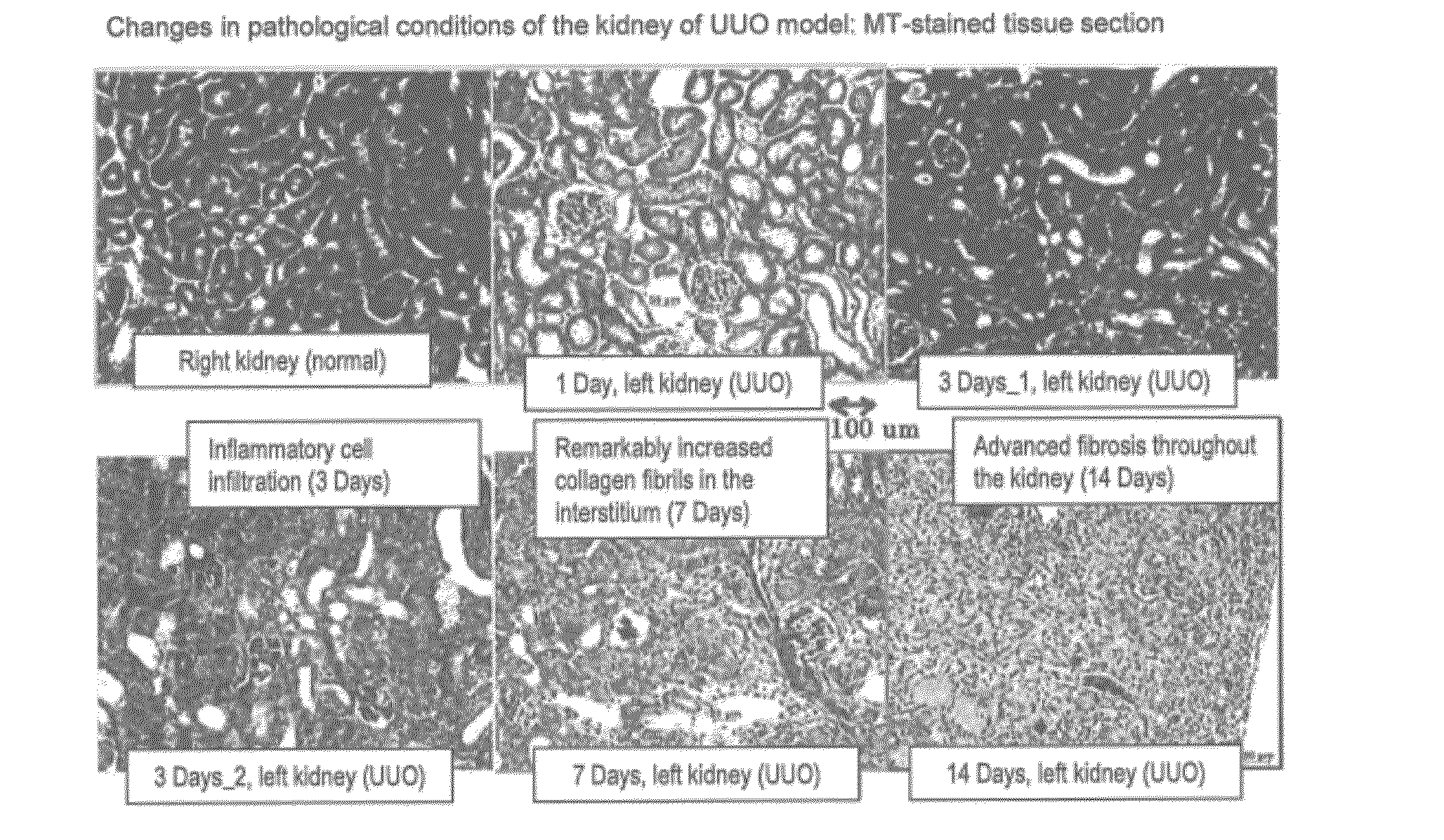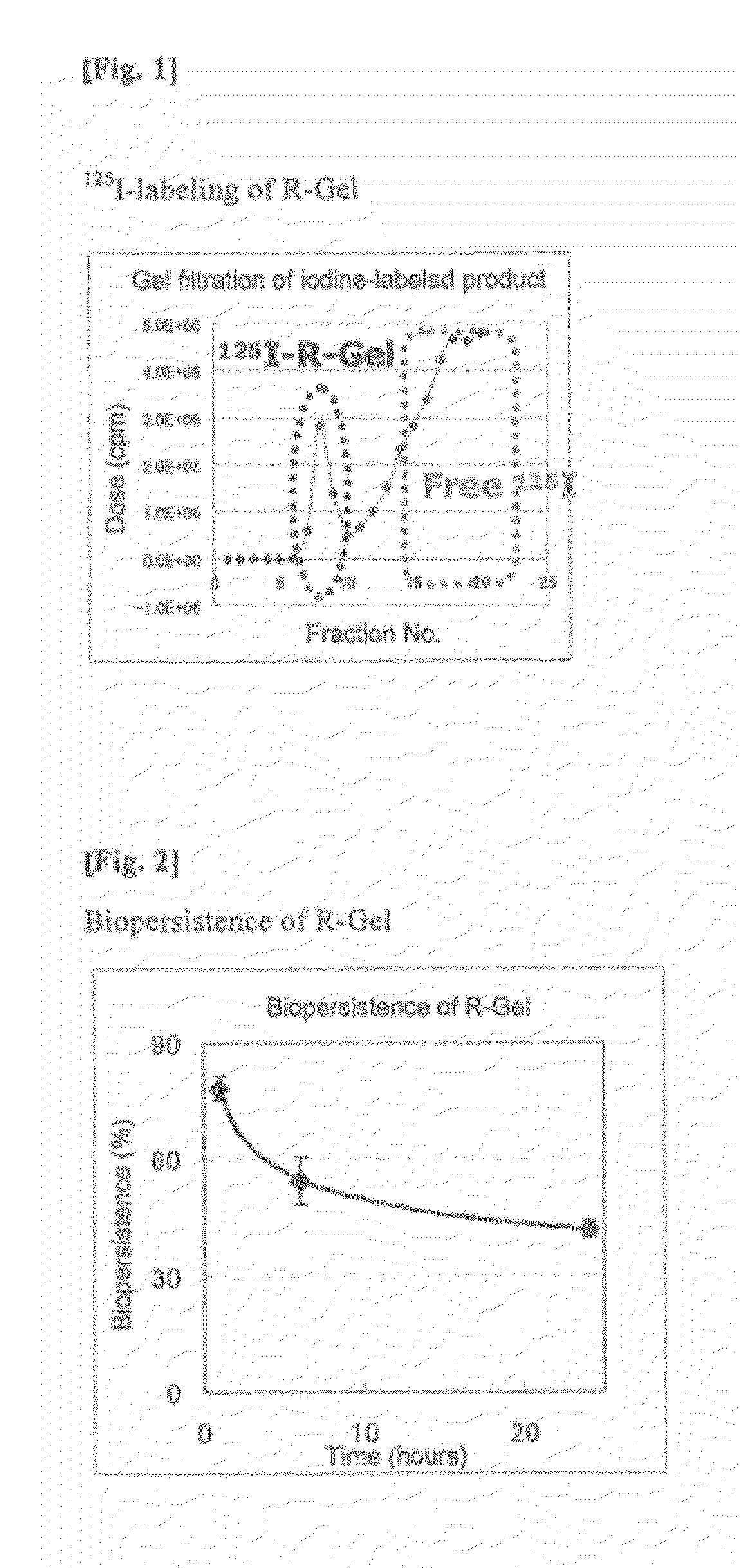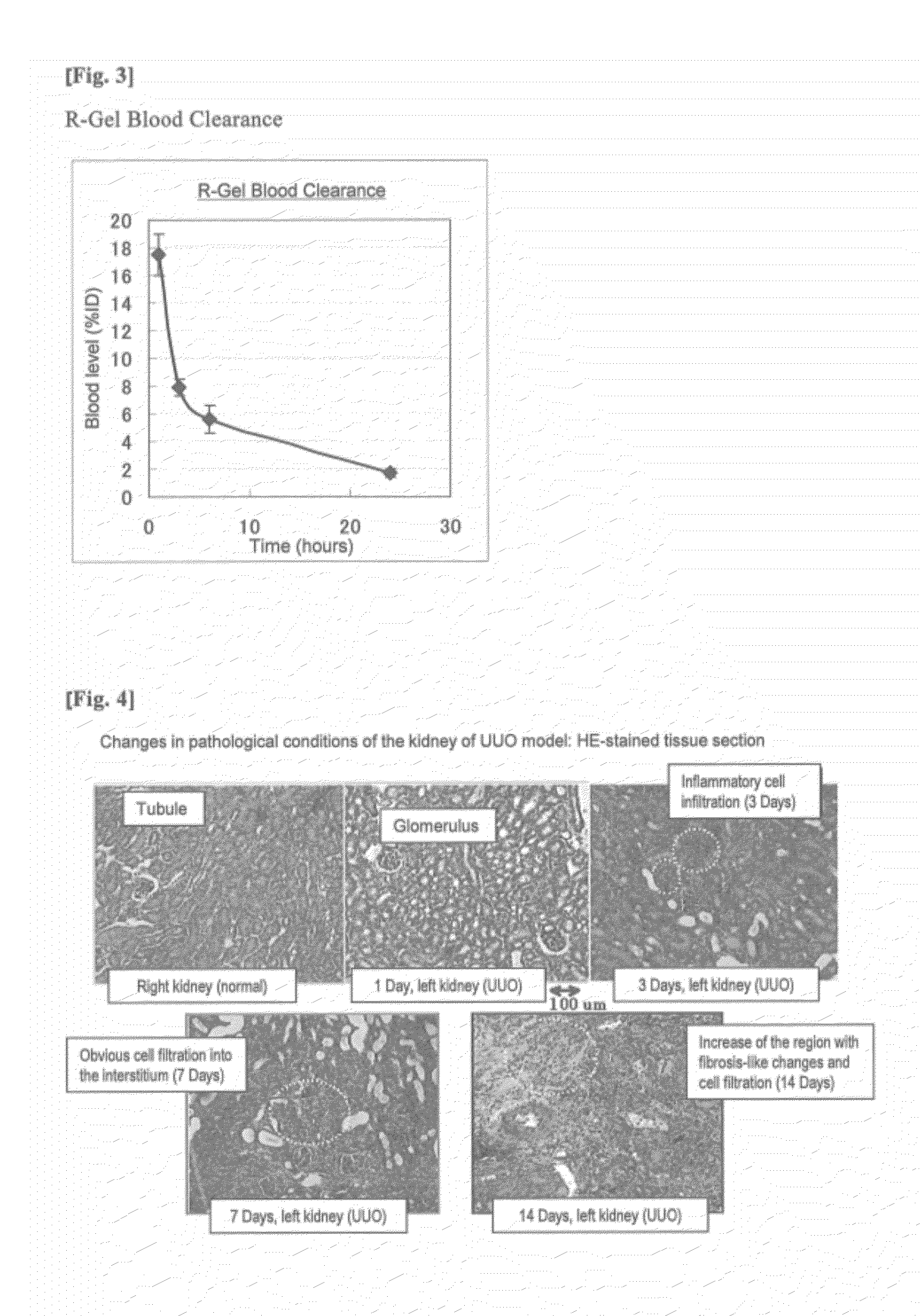Kidney-targeting drug delivery agent comprising recombinant gelatin
a drug delivery agent and recombinant technology, applied in the direction of antibacterial agents, immune disorders, extracellular fluid disorders, etc., can solve the problems of chronic renal failure, dialysis becomes necessary, and the qol of patients is remarkably impaired, and achieves the effect of higher accumulation
Inactive Publication Date: 2012-08-02
FUJIFILM CORP
View PDF5 Cites 4 Cited by
- Summary
- Abstract
- Description
- Claims
- Application Information
AI Technical Summary
Benefits of technology
[0040]Drug delivery to a kidney can be achieved with the use of the kidney-targeting drug delivery agent of the present invention by making use of its accumulation effects in the kidney. Moreover, the kidney-targeting drug delivery agent of the present invention is characterized in that it transiently accumulates in a kidney and particularly kidney functional units such as tubular epithelial cells for a short period of time and does not remain in the kidney for a prolonged time after accumulation. In addition, the kidney-targeting drug delivery agent of the present invention is characterized in that it has higher accumulation effects in an affected kidney than in a normal kidney.
Problems solved by technology
In addition, renal diseases progress as predicted, eventually resulting in “chronic renal failure.” As a result of symptomatic progression, dialysis becomes required.
Therefore, the QOL of patients is remarkably impaired.
At the same time, the medical cost required for dialysis is extremely expensive (¥1,300,000,000,000), causing an enormous burden on the total medical expense in Japan (¥33,000,000,000,000).
This has been problematic.
However, satisfactory drug treatment still has not been realized in clinical practice because such drug therapies are problematic in terms of levels of side effects upon non-kidney organs, efficacy, and the like.
However, there are various problems relating to the drug delivery system using these techniques.
It has been difficult to achieve effective delivery of drugs to kidney lesions in particular.
For example, when drug-carrying vesicles are used, drug-carrying vesicles are likely to be captured in the liver, spleen, or the like, making it difficult to achieve targeting of even a normal kidney.
Further, it is very difficult to perform separate targeting of normal kidney tissue and affected kidney tissue.
However, in spite of such large amounts of drugs passing through the kidney, substantial amounts of drugs are not transferred to kidney functional units but are excreted in urine.
Therefore, sufficient drug efficacy has not been exhibited in the kidney.
In addition, substantially no drug carriers capable of delivering a drug targeting a kidney or kidney functional units have been available.
This is significantly problematic.
For such reason, it is actually difficult to use the compound in practice.
In particular, the long-term retention of the compound in the kidney would increase the risk of unexpected drug-induced nephrotoxic side effects.
It is known that many drugs and contrast agents cause nephrotoxic side effects.
However, in the above case, it was found that the polyvinylpyrrolidone compound continuously remains in the kidney at high concentrations for several days or longer.
It has been impossible to solve this issue.
Further, it is impossible for the above polyvinylpyrrolidone compound to achieve separate targeting of normal kidney tissue and affected kidney tissue.
Therefore, the long-term retention of the compound in a normal kidney would inevitably increase the risk of unexpected drug-induced nephrotoxic side effects.
Therefore, it has been problematic that the compound cannot be used in practice as an agent targeting an affected kidney.
Therefore, the composition obviously lacks versatility and thus it is also not useful in practice as a diagnostic agent.
However, it has been unknown that biopolymers can be used for targeting of an affected kidney.
However, the above suggestion is limited to the use of the proteins as a substitute of natural gelatin.
Method used
the structure of the environmentally friendly knitted fabric provided by the present invention; figure 2 Flow chart of the yarn wrapping machine for environmentally friendly knitted fabrics and storage devices; image 3 Is the parameter map of the yarn covering machine
View moreImage
Smart Image Click on the blue labels to locate them in the text.
Smart ImageViewing Examples
Examples
Experimental program
Comparison scheme
Effect test
examples
[0099]As a recombinant gelatin, CBE3 (WO2008-103041) described below was prepared.
the structure of the environmentally friendly knitted fabric provided by the present invention; figure 2 Flow chart of the yarn wrapping machine for environmentally friendly knitted fabrics and storage devices; image 3 Is the parameter map of the yarn covering machine
Login to View More PUM
| Property | Measurement | Unit |
|---|---|---|
| adhesion | aaaaa | aaaaa |
| cell adhesion | aaaaa | aaaaa |
| hydrophobic | aaaaa | aaaaa |
Login to View More
Abstract
An object of the present invention is to provide a kidney-targeting drug delivery agent which is composed of bioabsorbable materials, transiently accumulates in a kidney and particularly kidney functional units such as tubular epithelial cells for a short period of time, and does not remain in the kidney for a prolonged time after accumulation. The present invention provides a kidney-targeting drug delivery agent which comprises a gelatin-like protein.
Description
TECHNICAL FIELD[0001]The present invention relates to a kidney-targeting drug delivery agent comprising a recombinant gelatin.BACKGROUND ART[0002]Kidney is an organ that filters waste products and excess water from blood to generate urine so as to maintain homeostasis of body fluid (extracellular fluid) and excrete protein metabolites such as urea. In addition, the kidney is responsible for regulation of endocrine secretion and metabolism such as vitamin D activation, erythropoietin production or renin production. Therefore, the kidney is known as a very important organ for the living body.[0003]Examples of kidney diseases include acute glomerulonephritis, chronic glomerulonephritis, nephrotic syndrome, pyelonephritis, hypertensive nephrosclerosis, diabetic glomerulosclerosis, nephrolithiasis, amyloid nephropathy, renal vein thrombosis, Alport syndrome, and renal tumor. The kidney is an organ having a complex structure. In general, deterioration of renal function is irreversible exc...
Claims
the structure of the environmentally friendly knitted fabric provided by the present invention; figure 2 Flow chart of the yarn wrapping machine for environmentally friendly knitted fabrics and storage devices; image 3 Is the parameter map of the yarn covering machine
Login to View More Application Information
Patent Timeline
 Login to View More
Login to View More Patent Type & Authority Applications(United States)
IPC IPC(8): A61K47/42A61P13/12A61P37/06A61P7/02A61P29/00A61P31/00A61K47/48A61P35/00
CPCC07K14/78A61K47/48292A61K47/6435A61P7/02A61P9/12A61P13/12A61P29/00A61P31/00A61P31/04A61P35/00A61P37/06
Inventor NAKAMURA, KENTAROTABATA, YASUHIKO
Owner FUJIFILM CORP
Features
- R&D
- Intellectual Property
- Life Sciences
- Materials
- Tech Scout
Why Patsnap Eureka
- Unparalleled Data Quality
- Higher Quality Content
- 60% Fewer Hallucinations
Social media
Patsnap Eureka Blog
Learn More Browse by: Latest US Patents, China's latest patents, Technical Efficacy Thesaurus, Application Domain, Technology Topic, Popular Technical Reports.
© 2025 PatSnap. All rights reserved.Legal|Privacy policy|Modern Slavery Act Transparency Statement|Sitemap|About US| Contact US: help@patsnap.com



